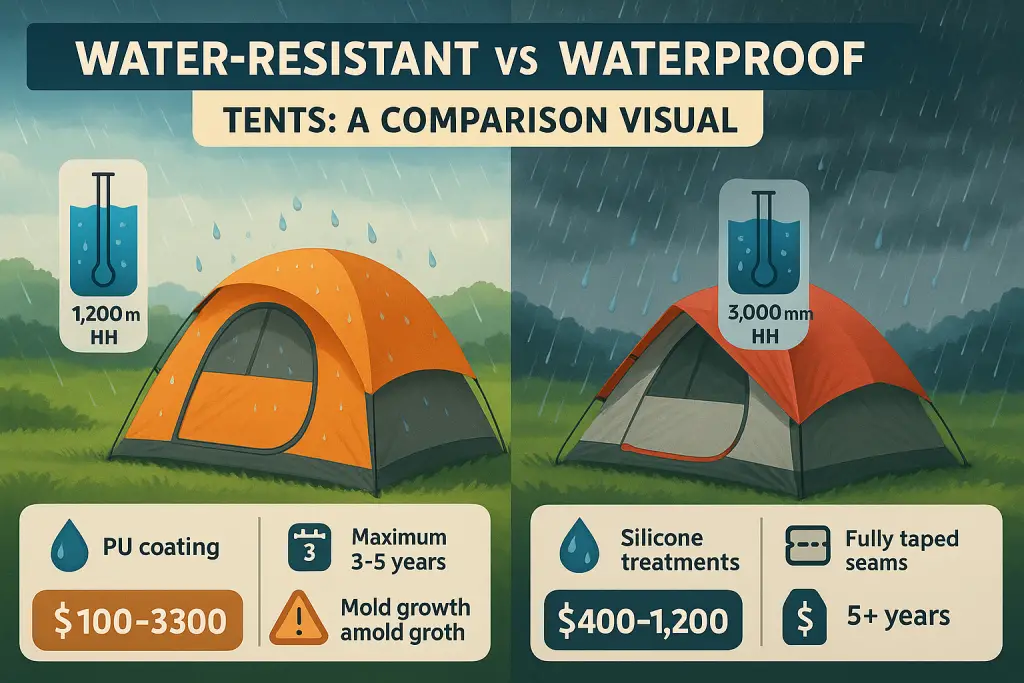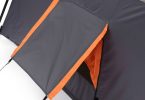We may receive commissions when you buy through the links on our site. Full Disclaimer.
Ever set up camp only to wake up in a puddle after a surprise midnight shower? I’ve been there, and it’s no fun feeling that first drop of water hit your forehead at 3 AM! Whether you’re planning a weekend camping trip or gearing up for a multi-week expedition, understanding the difference between water-resistant and waterproof tents can make or break your outdoor adventure. You’ve landed on the right page to finally clear up this crucial distinction.
I’ll guide you through everything from hydrostatic head ratings to material technologies that keep you dry (or not). By the end of this post, you’ll know exactly what level of protection your adventures demand.

Understanding the Critical Differences That Impact Your Camping Experience
The distinction between water-resistant and waterproof tents isn’t just marketing jargon—it’s about fundamentally different protection levels. Water-resistant tents temporarily repel moisture, while waterproof tents provide complete water impermeability.
Water-resistant options might save you money upfront, but they can cost you in comfort and gear damage when the weather turns. In contrast, a proper waterproof tent keeps you bone-dry through extended downpours and can be the difference between an enjoyable trip and a miserable one.
The Industry Standard: Hydrostatic Head
Tent manufacturers measure water resistance using something called a hydrostatic head (HH) rating. This tells you how much water pressure the fabric can withstand before leaking.
The international standard requires a minimum threshold of 1,500mm hydrostatic head for a tent to be classified as waterproof. Anything below this is considered merely water-resistant and suitable only for fair weather camping.
Decoding Hydrostatic Head Ratings: Your Tent’s First Line of Defense
Hydrostatic head might sound technical, but it’s surprisingly straightforward. It measures how tall a column of water (in millimeters) the fabric can support before water begins to seep through.
Imagine placing a tube on top of your tent fabric and filling it with water. The height of water the fabric can hold back before leaking is its hydrostatic head rating. Pretty simple, right?
Rating Tiers and Real-World Performance
- Below 1,500mm: Only suitable for light rain showers of short duration. Expect dampness during extended exposure.
- 1,500-3,000mm: Can handle moderate rainfall for 24-48 hours. Good for typical weekend adventures.
- 3,000-5,000mm: Excellent protection for multi-day storms and high-altitude conditions where pressure is greater.
- Above 5,000mm: Extreme weather protection for serious adventurers facing monsoon conditions or prolonged exposure.
Take the popular MSR Hubba Hubba NX, for example. It features a 3,000mm HH DuraShield® coating that stands up brilliantly to extended foul weather, making it a favorite among serious backpackers who don’t let rain cancel their plans.
Material Technology: The Science Behind Water Protection
The fabrics and treatments used in tent construction make all the difference between staying dry or getting soaked.
Water-Resistant Materials
Water-resistant tents typically use nylon (ranging from 30D-70D thickness) or canvas with basic polyurethane (PU) coatings. These materials provide hydrostatic head ratings between 600-1,500mm – enough to shed light rain but not to withstand sustained precipitation.
These tents prioritize breathability and weight savings over storm protection. While they’re perfect for summer camping in fair weather, they’re the wrong choice for unpredictable conditions.
Waterproof Construction
Truly waterproof tents employ advanced materials like PVC-coated polyester, silicone-treated ripstop nylon with 3,000-5,000mm HH ratings, or ultra-premium Dyneema® composites.
The quality of seam construction is equally crucial. Water-resistant tents typically use standard stitching, creating tiny holes that eventually let water through. Waterproof tents feature fully taped seams with impregnated threads that seal completely against moisture.
Here’s a key fact: Silicone and Teflon coatings significantly outperform PU in durability, typically maintaining their waterproof properties for 2+ years longer under similar conditions. This makes them a better long-term investment despite their higher initial cost.
Real-World Performance Comparison: Making the Right Choice for Your Adventure
Understanding the technical differences is helpful, but how do these tents actually perform when you’re out in nature? Let’s break it down:
| Factor | Water-Resistant Tents | Waterproof Tents |
|---|---|---|
| Material Breathability | High (prevents condensation) | Moderate (prioritizes water protection) |
| Weight | 1.5-4.7kg (lighter for backpacking) | 4.7-9.8kg (heavier but more protective) |
| Price Range | $100-$300 | $400-$1,200 |
| Typical Lifespan | 3-5 years with proper care | 5+ years of reliable performance |
| Best Uses | Day trips, fair weather camping | Extended expeditions, unpredictable conditions |
Research from Sheltent, NTK Global, and Boutique Camping confirms these differences aren’t just theoretical—they directly impact camper comfort and safety in the field.
While water-resistant tents excel in ventilation and packability for family camping trips in predictable weather, they simply can’t match the security of a properly waterproof tent when conditions deteriorate.
Weather Vulnerability: When Water-Resistant Options Fall Short
Water-resistant tents have some significant limitations you should know about before making your purchase:
The Weakest Links
- Seam leakage: Thread holes let water seep through during prolonged rain exposure
- Mold growth: Retained moisture creates perfect conditions for mildew development
- Degradation timeline: PU coatings typically break down after 3-5 years of regular use
Water-resistant tents perform adequately in light, brief showers. However, they’re completely unsuitable for storms or multi-day wet weather camping. If you’re heading into regions with unpredictable weather, a water-resistant tent is a risky choice.
UV Degradation Impact
The polyurethane coatings used in water-resistant tents are particularly vulnerable to UV light. Extended sun exposure causes these coatings to break down more quickly, further reducing their already limited water protection capabilities.
If your camping style involves leaving your tent set up for days at a time in sunny locations, expect the water resistance to decline even faster than the manufacturer estimates.
Top-Rated Tents Across the Spectrum: Expert Recommendations
Let me share some solid tent recommendations based on your needs and budget:
Water-Resistant Recommendations
Kelty Late Start 2
- Hydrostatic head: 1,200mm
- Material: PU-coated nylon
- Weight: 1.8kg
- Price: ~$160
- Perfect for: Summer weekend camping in fair weather
Coleman Sundome
- Hydrostatic head: 1,000mm
- Material: Polyester with weather-resistant coating
- Weight: 3.2kg
- Price: ~$80
- Perfect for: Budget-conscious campers in dry climates
Waterproof Recommendations
MSR Hubba Hubba NX
- Hydrostatic head: 3,000mm
- Material: Silicone/nylon hybrid
- Weight: 1.7kg
- Price: ~$480
- Perfect for: Serious backpackers facing variable conditions
Kelly Kettle Ultralight Tarp
- Hydrostatic head: 3,000mm
- Material: Silnylon
- Weight: 640g
- Price: ~$120
- Perfect for: Ultralight hikers seeking emergency shelter
Mastertent Canopy Pro
- Hydrostatic head: 2,000mm
- Material: PVC-coated polyester
- Weight: 9.5kg
- Price: ~$850
- Perfect for: Base camping and extended outdoor events
For those facing particularly challenging conditions, check out my guide to the best waterproof tents for more specialized options.
Maintenance and Longevity: Maximizing Your Investment
The care requirements between these tent types differ dramatically, impacting both your effort and long-term costs.
Waterproof Tent Advantages
Waterproof tents require less maintenance thanks to their self-cleaning PVC surfaces and inherent mold resistance. Many high-end models can withstand 500+ nights of use before showing significant performance decline.
I recommend annual seam sealing for waterproof tents to maintain their integrity. This simple maintenance step ensures your investment continues to perform at its best for years to come.
Water-Resistant Tent Care
To keep water-resistant tents functional, you’ll need to apply waterproofing spray to refresh the PU coating roughly twice a year, depending on usage. They also require meticulous drying and ventilation after each trip to prevent mildew and mold growth.
The extra effort required to maintain water-resistant tents is something many campers don’t consider when making their initial purchase decision.
Making Your Decision: Matching Tent Type to Your Outdoor Activities
The right tent for you depends entirely on how, where, and when you plan to use it. Here’s my practical advice:
For Weekend Warriors
If you’re a fair-weather camper who checks forecasts religiously and only heads out when conditions look favorable, a quality water-resistant tent might serve you well while saving you money.
For Adventure Seekers
If you camp in all seasons, venture into remote areas, or simply want to sleep soundly regardless of what Mother Nature throws at you, invest in a proper waterproof tent. The extra cost upfront saves you stress and potential gear replacement down the line.
Final Recommendation
For maximum long-term value, prioritize tents with 3,000mm+ hydrostatic head ratings, fully taped seams, and UV-stable coatings. These features ensure your shelter will protect you through a wide range of conditions and last for many adventures to come.
Remember, the best tent isn’t necessarily the most expensive one—it’s the one that provides the right level of protection for your specific adventures and conditions. Choose wisely, and you’ll enjoy many dry, comfortable nights under the stars!
Have you had any memorable experiences with tent leakage? Or perhaps you’ve found the perfect waterproof tent that’s stood up to challenging conditions? Share your stories in the comments below!




